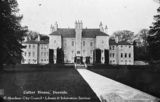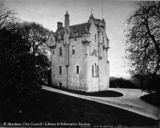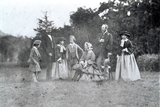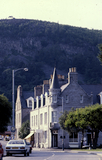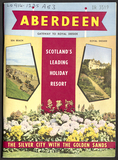|
Quick Search
|
Search Results
You searched for: Subject matches "Deeside" or its children
18 items
items as
Culter House
261 Culter House, Deeside. The building was destroyed by fire in 1910 and subsequently re-built. The Linn o' Dee, c.1880
359 The Linn o'Dee is 65 miles west of Aberdeen and over 1200 feet above sea level. It is about a mile west of Inverey, the last settlement on Deeside and marks the end of the public road. The stone bridge which replaced a wooden structure was opened by Queen Victoria in September 1857. Salmon can often be seen here leaping upwards to their spawning grounds. The area is still a popular tourist attraction with views of the Cairngorms in the distance. Linn is a Scottish word for a rocky gorge with pools. Balmoral Castle
1107 A George Washington photograph of Balmoral Castle from the north, looking towards Lochnagar. Loch Callater
1881 A GWW photograph of Loch Callater near Braemar.
Note the chap reclining in the foreground. The Royal Family at Balmoral
2613 A photographic group portrait of Queen Victoria and her family while in residence at Balmoral Castle. The Invercauld Arms Hotel
3015 A photograph of the Invercauld Arms Hotel in Braemar. This image likely dates from shortly after the extension of the hotel in 1886. Mill on the Clunie
3016 A photograph, looking south west, by James Valentine showing the Mill on the Clunie in Braemar.
Also known as the Mill of Auchendryne, the building dates from the late 18th century and originally functioned as a granary. It was turned into private housing in the late 20th century.
The Clunie Water is a tributary of the River Dee. Mill on the Clunie
3017 A photograph, looking south west, showing the Mill on the Clunie in Braemar. Mannofield Cricket Ground
3175 A postcard image showing a match between Braemar and Aberdeenshire at Mannofield Cricket Ground. The inscription on the right indicates the photograph was taken from inside the ground's pavilion.
The postcard was published by E. Groundwater at the Mannofield Post Office. Main Street Ballater
4222 This photograph looks north west along Bridge Street in Ballater.
The Coach House Hotel, with its Scots baronial style turret, can be seen at the junction with Netherley Place. Since 1994 this property has been the Balmoral Bar.
The hill visible in the background of this image is Craigendarroch, which is Gaelic for "hill of oaks".
This image likely dates from the 1970s. It is a part of a collection of slides donated to Aberdeen City Libraries by Aberdeen City Council's Publicity department. Glenmuick Parish Church
4223 A photograph looking south from Bridge Street in Ballater towards the front elevation of Glenmuick Parish Church. A small part of Ballater's war memorial can be seen seen on the left.
Glenmuick Parish Church was built in 1873-74 to a design by Aberdeen architect John Russell Mackenzie (1833-1889). Describing its historical importance on their listed buildings portal, Historic Environment Scotland state the following:
"Francis Farquharson, and later his brother William, planned Ballater in the late 18th century, following the discovery that the Pannanich Wells across the River Dee were deemed to have miraculous healing qualities. This led to a steady stream of visitors and Ballater was planned as a village that could house them. The village was based on a rectilinear plan with the church at its centre. This early church was a simple building with a wooden steeple and was built to accommodate the people of the three surrounding parishes - Glengairn, Tullich and Glenmuick. It was consecrated in 1800.
"With Queen Victoria's interest in Balmoral in the 1850s and the arrival of the railway to the town in 1866, Ballater grew more prosperous and the older church was thought not be sufficiently in keeping with the new more prosperous town and the present church was built."
The war memorial in the bottom left, designed by Sir John J. Burnett, commemorates soldiers who died in World War I and II. It was unveiled on 23rd July 1922 (Press & Journal, 24th July 1922).
This image likely dates from the 1970s or 80s. It is a part of a collection of slides donated to Aberdeen City Libraries by Aberdeen City Council's Publicity department. River Dee and Creag nam Ban
4224 A photograph, looking east, showing the River Dee between Ballater and Braemar. Beyond the river is the outline of Creag nam Ban and Sgor an h-Iolaire. These hills stand to the south east of Abergledie.
This image likely dates from the 1970s or 80s. It is a part of a collection of slides donated to Aberdeen City Libraries by Aberdeen City Council's Publicity department. Ballater fountain
4225 This photograph shows the commemorative drinking well or fountain located in the centre of Ballater, across the road from the war memorial and Glenmuick Parish Parish.
The plaque on the fountain reads "Presented to Lieut. Col. Farquharson and the inhabitants of Ballater by Hugh Rose, 1884."
Hugh Ross (1807-1888) was the provost of Ballater. James Ross Farquharson of Invercauld (1834-1888) was a prominent land owner and descendant of the founders of Ballater.
The opening of the fountain took place on Wednesday 8th October 1884. An account can be read in the following day's Aberdeen Journal on page 2.
A melancholy accident unfortunately marred the day. At the end of the opening ceremony an old cannon located on Craigendarroch was fired by a Sergeant Charles McLagan of the Ballater Volunteers. Due to the cannon's age the charge burst the gun and severely injured McLagan. He was taken to Aberdeen Royal Infirmary for treatment but died the next morning.
The tree in the foreground of this image looks like a Scots pine or similar. In the background is a partial view of nos. 4 and 6 Hawthorn Place. In between two people can be seen enjoying the sun. One lying on the ground and another reclining on the bench.
This image likely dates from the 1970s or 80s. It is a part of a collection of slides donated to Aberdeen City Libraries by Aberdeen City Council's Publicity department. Aberdeen Official Holiday Guide
455 The front cover of an official holiday guide produced by Aberdeen Corporation Publicity Department. These guides were created to promote the city as a holiday destination and to assist visitors to plan their visit. The guides were distributed both locally and around the UK. This one looks to date from the 1960s.
The front cover features three prominent slogans that were used to promote Aberdeen: "Gateway to Royal Deeside", "Scotland's Leading Hoilday Resort" and "The Silver City with the Golden Sands". It highlights the beach, castles and ornamental gardening as key elements in the appeal of the city.
The title page of the guide features an illustration of Aberdeen's tourism mascot, a Scottish Terrier, and lists H. Webber as the director of publicity.
One interesting feature of the guide is the range of adverts for local hotels and guest houses of the period. Many include photographs of the exterior or interior. |





